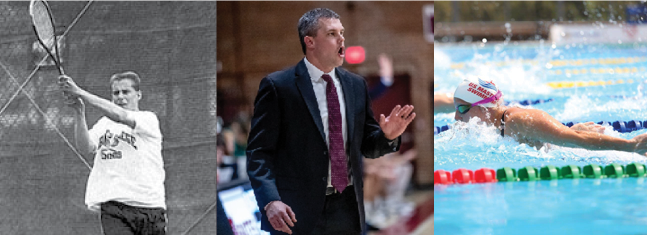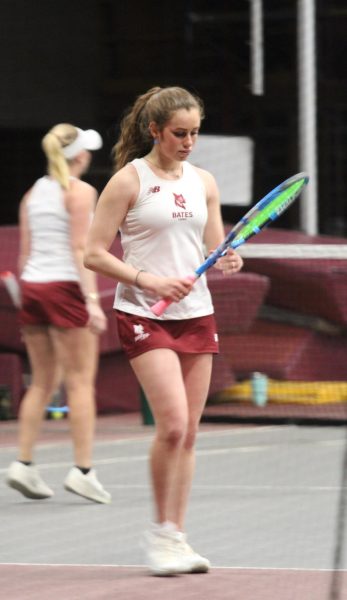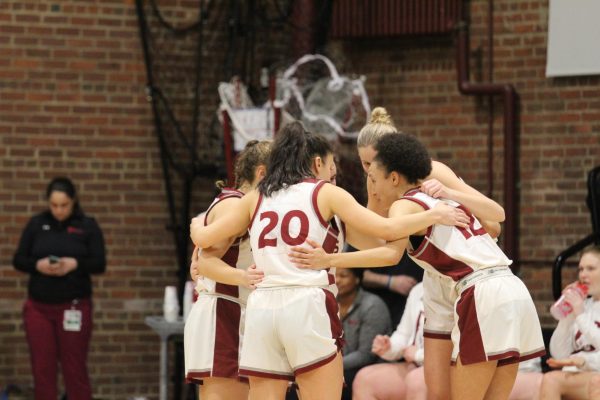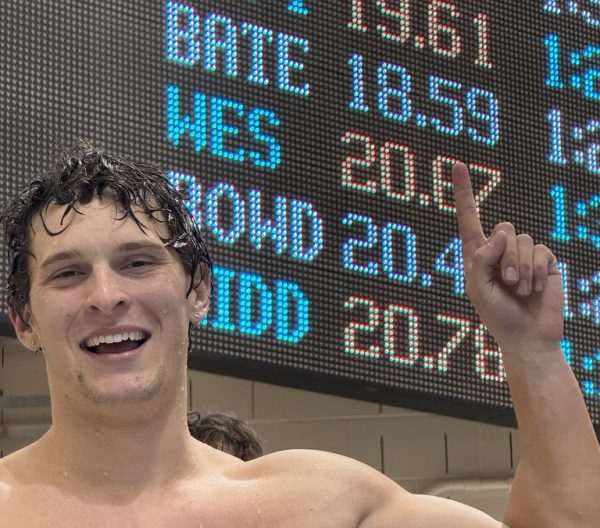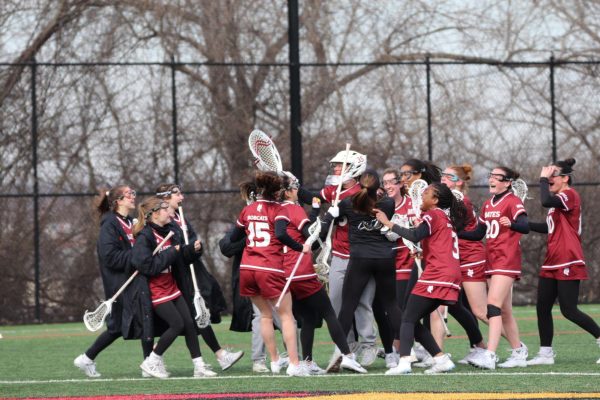Bobcat Blood Runs Deep
Gastonguay ’89, Williamson ’05, and Furbush ’05 Discuss Coaching at Bates
Bates College/Phyllis Graber Jensen/Bates Swim and Dive Facebook
Left to right: Tennis Coach Paul Gastonguay ’89, Men’s Basketball Coach Jon Furbush ’05, and Swimming and Diving Associate Coach Vanessa Williamson ’05.
While many student-athletes graduate from Bates without any intentions of continuing their athletic passions or returning to Lewiston, graduation for Paul Gastonguay ’89, Vanessa Williamson ’05, and Jon Furbush ’05 was not the end of their Bates athletic careers. All returning to Bates less than 10 years after graduation, Gastonguaguay, Williamson, and Furbush were pulled back into the family of Bates athletics.
Head Men’s and Women’s Tennis Coach Gastonguay ’89 graduated as the winningest tennis player in Bates history and set three of the top four single-season marks during his four-year playing career. After playing professionally for four years and working at a junior development program, he was given the opportunity to return to Bates.
“I got a call from Suzanne Coffey, the athletic director at the time, and she asked me why I hadn’t applied for the open coaching position,” Gastonguay said. He was only 28 years old when he took over as head coach for the men’s squash and tennis teams. “I just felt like I should be here,” he said.
Associate Head Swimming Coach Vanessa Williamson ’05 graduated as an eight-time All-American performer in the butterfly and individual medleys. She was training for the 2008 Olympic Trials when Coach Peter Casares took over the program as head men’s and women’s swimming and diving coach.
“I immediately introduced myself to him,” said Williamson. “When I finished my swimming career, I immediately got the coaching bug and began coaching middle school and high school athletes in Los Angeles.” However, this “bug” eventually brought her back to Lewiston, and she took over as an assistant coach in 2012. She was promoted to associate head swim coach in 2016.
Jon Furbush ’05, Head Men’s Basketball Coach, was coaching at Springfield College when the opportunity to return to Bates presented itself.
“It was a dream job to come back to Bates,” said Furbish. “I knew I wanted to be here. I really believe in the institution and what we stand for in athletics and honestly, I was really shocked that I became head coach at 25 years young.” During his first coaching season, Furbush was the youngest head men’s basketball coach in the NCAA.
As Bates alumni, Gastonguay, Williamson, and Furbush know the ins and outs of the Bates experience, giving them unique perspectives as coaches.
“I understand what every student-athlete is going through, because I went through it myself,” said Gastonguay. “I’m very familiar with the academic rigor and what the academic load is like. I know when to back off, I know when to push, and I know when I need to give them more rest. [Being an alum] has really served me well, and I knew that right from the start it was a huge advantage.”
Williamson echoed similar sentiments. “My success at Bates helped me get to California to train for the ’08 trials, which helped me gain confidence as a swimmer, helping me become the coach I am today,” she said.
Furbush believes that being an alum has not only helped him understand his athletes more but also proven valuable in the recruiting process: “[being an alum] makes recruiting a lot easier, because I’m able to talk about the school in ways that are personal, because I’ve gone through the experiences myself, so I’m able to connect with families and recruits from the get-go.”
When asked about the differences between his experience as a student-athlete in the 80s and as a coach now, Gastonguay said that “it was a different time in terms of what our goals were as coaches. When I was a student-athlete at Bates, several coaches were coaching multiple sports over different seasons. They were multi-tasking, and they all had a heavy load.”
He added, “It was more of a prep school model where many of the coaches were educators. Coaches now are much more specialized and ready to take their programs to the next level, and that was my goal when I came in.”
For Furbush, the biggest difference has been the competitiveness of the NESCAC. “When I played at Bates, Hamilton wasn’t even in the NESCAC. It wasn’t nearly as hard to get into the playoffs, let alone win a playoff game, whereas now the No. 8 seed could beat the No. 1 seed easily. The degree of separation in basketball is so small. One to two games max, and winning the league now is harder than it has ever been, which is great because it makes every game that much more important for our guys.”
Furbush noted that winning games is a hard earned achievement. “The success is real,” he said. “It’s not like we beat a team that wasn’t very good. Any NESCAC team you beat is still very, very good. Winning in this conference is so challenging.”
Williamson emphasized the degree of similarity between her time as a student in the early 2000s and her time now as a coach. “The type of athlete Bates attracts hasn’t changed much since my time,” she said. “They know how to put in the work, are talented, and want to achieve greatness.”
However, she also spoke to important differences saying that the “swim and dive team has increased its team size, raised its rankings in the NESCAC and at the NCAA level, and attracted a more diverse team.”
When asked about what makes Bates athletics so special, all three coaches couldn’t help but talk about the inspiration they receive from their athletes.
“What really drives me is the ability to be out there with [the student-athletes] and helping them achieve their goals. It’s just so fun to be with the athletes…and that’s why I do what I do,” said Gastonguay. “Bates is a family, and we’re there for the students.”
“I just feel so lucky to work with the athletes that I do,” remarked Furbush. “They’ve made me think in ways I’ve never had to, because they’re just so smart. I’ve just been so lucky to coach such smart, motivated, young people.”
“They want to be part of it,” he continued. “They show up every day wanting to get better. They want to be coached, and they’re doing it because what we’re doing here is so much bigger than ourselves. Winning is important, but the relationships that I’ve built with my guys over the last 13 years… I wouldn’t trade it for anything.”
Williamson believes that the athletes at Bates truly love their sports, love repping the Bobcat, and love making their coaches and team proud. “They are very supportive of each other on campus and want to be the best they can be. I love working with this student body. They put in the work, trust us as coaches, work together, push their teammates, and have a lot of fun doing it,” she said. “It really helps to head to work every day when one enjoys the people they are surrounded by.”
Your donation will support the student journalists of Bates College and help us cover our annual website hosting costs.


